Catalog of Spanish coins in peseta
| Provisional Government 1868 - 1871 |
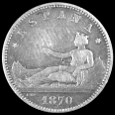 |
Amadeo I 1871 - 1873 |
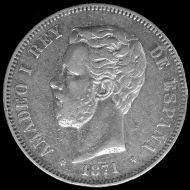 |
| First Republic 1873 - 1874 |
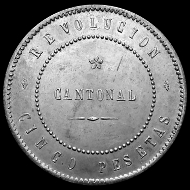 |
Alfonso XII 1874 - 1885 |
 |
| Alfonso XIII 1886 - 1931 |
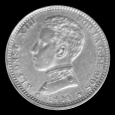 |
Second Republic 1931 - 1939 |
 |
| Spanish State 1939 - 1975 |
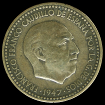 |
Juan Carlos I 1975 - 2001 |
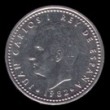 |
The peseta was born in the context of the Latin Monetary Union on October 19th, 1868 after the adoption of the decimal metric system in the Spanish coinage.
The name peseta, which meaning in Spanish is "small weight", was already used for the 2-real piece in the XVII century, and the 4-real piece, moreover, pesetas were used in Catalonia during the Spanish war of Independence.
The coins of the new monetary system considered in the decree presented by the Minister for the Treasury Laureano Figuerola were engraved by Luis Marchionni, master engraver in the Mint of Madrid since 1861:
- in bronze: 1 centime, 2 centimes, 5 centimes and 10 centimes;
- in silver: 20 centimes, 50 centimes, 1 pesetas, 2 pesetas and 5 pesetas;
- in gold: 5 pesetas, 10 pesetas, 20 pesetas, 50 pesetas and 100 pesetas.
The gold coins were not minted, and the only coins struck were a trial 100 pesetas with the Spanish royal coat of arms on the reverse.
The first issuing of silver coins was in 1869, with the 1 peseta with the name “Provisional Government” on the front, substituted by the name “España” on the subsequent emissions. The image on the obverse came from the Roman coins of the emperor Hadrian, with a personification of Hispania lying across the Pyrenees, with Gibraltar at her feet, and an olive branch in her hands. On the reverse, the silver coins portrayed the Spanish coat of arms.
The bronze coins represented Spain as a matronly figure seated on the rocks on the obverse, and an olive branch in her hand. On the reverse, the bronze coin portrayed the Spanish coat of arms supported by a rampant lion.
Following the restoration of the Monarchy, the image of Hispania on the obverse was replaced by effigy of the king, and on the reverse the escutcheon of the reigning house was added to the Spanish coat of arms:
- the cross of Savoy under the reign of the Italian Amadeus I;
- the fleur de lis under the Bourbon monarchy of Alfonso XII, Alfonso XIII, and Juan Carlos I.
A new denomination of 25 pesetas was struck. In 1925 a 25 centimes in cupro-nickel was issued, and in 1927 the first Spanish coin with a hole in the centre was minted.
In the 1930s, during the Spanish civil war, the peseta was split into the Nationalist and Republican one. During the Second Republic (April 14th, 1931 - April 1st, 1939) new motifs of Republican inspiration were used on the Spanish coins, with very simple typefaces and the wording reduced to the value and the entity that released them.
In order to face the lack of precious metals, copper, nickel and aluminum were adopted for minting, with the gold abandoned since 1904 and the silver since 1933, loosing the equivalence between the coin’s face value and the value of the coin’s.
In 1947, with the government of General Franco, the peseta adopted a head modeled by the sculptor Mariano Benlliure and the engraver Manuel Marin, substituted from 1966 by a new image made by Juan de Avalos. On the reverse came back the coat of arms of the traditional Catholic Monarchs.
The same approach was used after the establishing of the democracy by the king Juan Carlos I.
The inflation under Franco's dictatorship was very high, causing devaluation in 1967.
Since 1990, the tradition of representing the on the obverse ruler, and on the reverse the Spanish coat of arms was substituted by different commemorative coins minted every year, with the exception of the 1 peseta and 500 pesetas coins.
Moreover, to face the confusion in the shape of the 2 peseta, 5 peseta, 100 peseta and 200 peseta coins, a new coinage was designed with a coin size increasing with the value, and alternating colors for the metal, removing the rest of the coins from circulation after 1997.